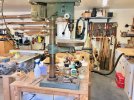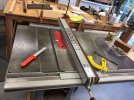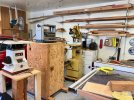When I first started this adventure, I used some new and salvaged wood to build my work table. I'm thinking I went a bit overboard.
The table is 4' x 8'. I have it on swivel, locking casters and have a 5 drawer tool cabinet built in to it.
Turning to the experts here - What is a usable, appropriate size for a work table? I'm running out of room. The table saw and jointer are moveable. I plan on either buying or building a stand for the planer. I have a benchtop drill press and vise mounted to another 28"x54" bench on casters.
I want an area to work, sanding, assembling, etc. It also will have to house my miter saw and router.
What works for you?
The table is 4' x 8'. I have it on swivel, locking casters and have a 5 drawer tool cabinet built in to it.
Turning to the experts here - What is a usable, appropriate size for a work table? I'm running out of room. The table saw and jointer are moveable. I plan on either buying or building a stand for the planer. I have a benchtop drill press and vise mounted to another 28"x54" bench on casters.
I want an area to work, sanding, assembling, etc. It also will have to house my miter saw and router.
What works for you?



